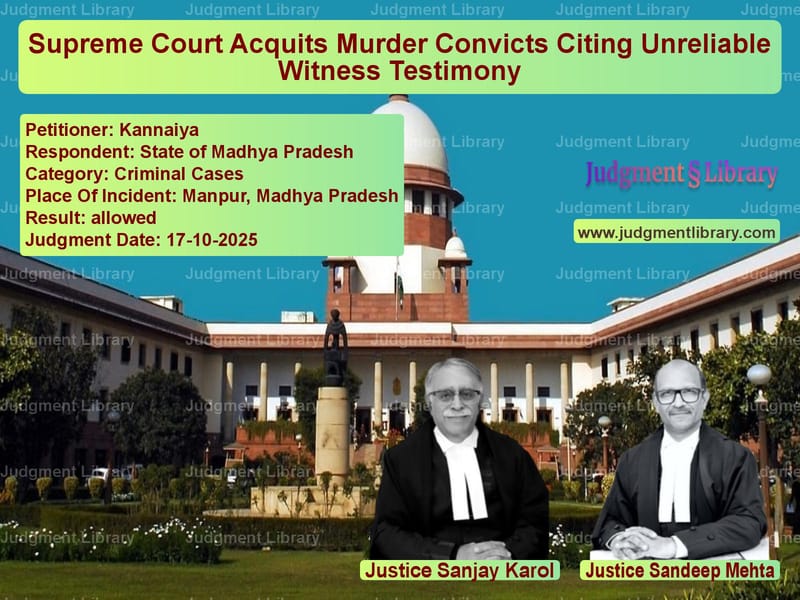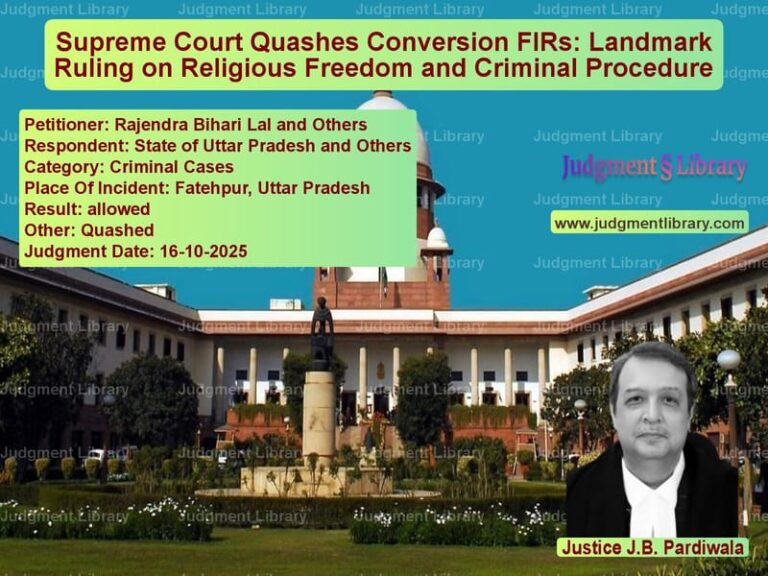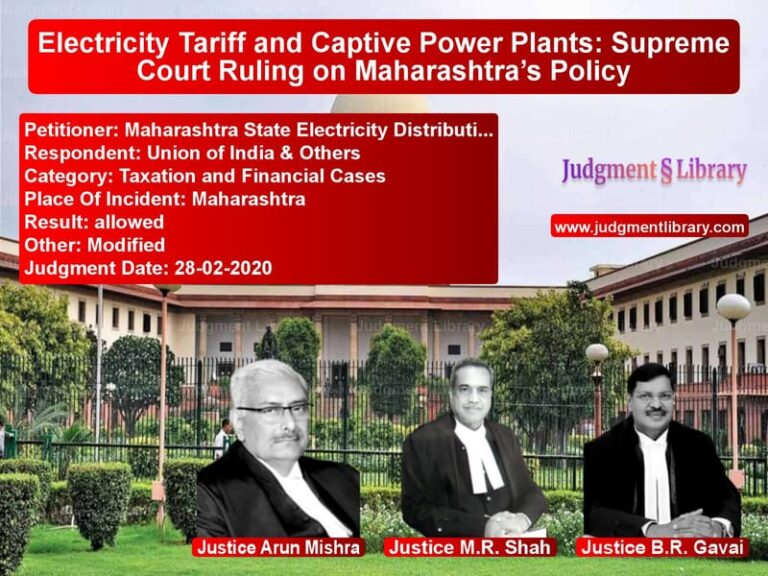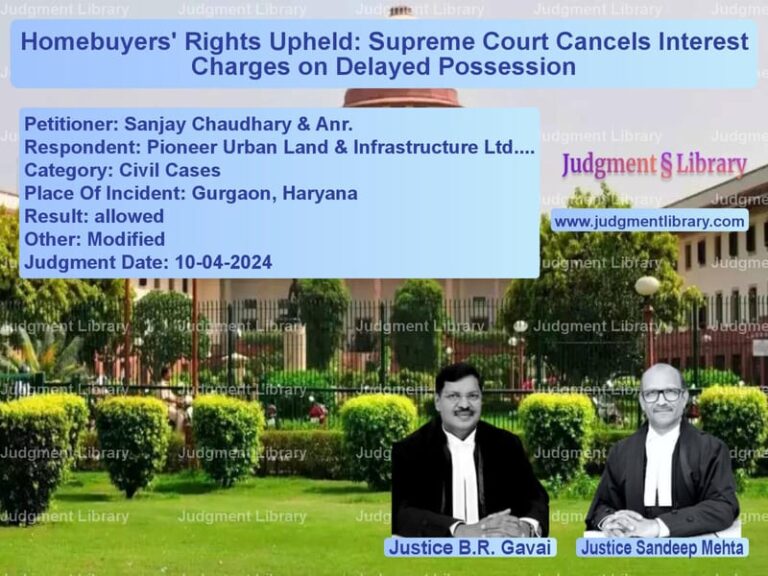Supreme Court Acquits Murder Convicts Citing Unreliable Witness Testimony
In a landmark judgment that underscores the critical importance of reliable witness testimony in criminal convictions, the Supreme Court of India has acquitted four men who were serving life imprisonment for a murder that occurred over three decades ago. The case of Kannaiya versus State of Madhya Pradesh represents a classic example of how contradictions in witness statements and lack of clarity about the basic facts of a case can lead to the collapse of the prosecution’s narrative. The judgment, delivered by a bench comprising two esteemed judges, meticulously analyzed the evidence and found that the two key eyewitnesses presented by the prosecution gave completely contradictory versions about where the murder took place and how it began. This ruling not only brings relief to the appellants who have spent years in prison but also serves as an important reminder of the high standards of proof required in criminal cases, especially those involving the most serious of charges.
The Tragic Incident and Initial Proceedings
The case dates back to September 28, 1990, when a violent altercation in a small village in Madhya Pradesh led to the death of a young man named Ramesh. According to the First Information Report (FIR) lodged by Ramesh’s father, Gobariya, the incident began when ten accused persons started damaging a temporary hutment belonging to another villager named Jagya. When Ramesh intervened to pacify the situation, the assailants turned on him and assaulted him with various weapons including swords, axes, and sticks. The attack left Ramesh with multiple severe injuries, and despite being rushed to medical facilities, he succumbed to his injuries on October 5, 1990, while undergoing treatment at a hospital in Indore.
The postmortem report documented ten separate injuries on Ramesh’s body, including wounds on his forehead, face, head, stomach, ankle, and thigh, with several requiring stitches. There was a dislocated fracture on his lower jaw and broken teeth, painting a grim picture of the brutality of the assault. The police investigation led to the arrest of all ten accused persons named in the FIR, and weapons including a sword and an axe were seized. After a lengthy trial, the First Additional Sessions Judge in Mhow convicted four of the ten accused – Kannaiya (the appellant), Govardhan, Raja Ram, and Bhima – under Section 302 (murder) read with Section 34 (common intention) of the Indian Penal Code, sentencing them to life imprisonment. The remaining six accused were acquitted. The convicted individuals appealed to the Madhya Pradesh High Court, which upheld their conviction in 2009, leading to the present appeal before the Supreme Court by Kannaiya.
The Contradictory Witness Accounts
The Supreme Court’s judgment primarily revolved around the reliability of the two key eyewitnesses presented by the prosecution – Madho Singh (PW-5) and Puniya (PW-12). The Court found that these witnesses gave fundamentally different versions of the same incident, raising serious doubts about their credibility and presence at the crime scene.
The FIR stated that the incident began when the accused were damaging the hut of Jagya (PW-3), and Ramesh intervened. However, Madho Singh (PW-5) completely denied this version in his testimony. He claimed that the incident started when the accused persons came to the house of someone named Narsingh and began acting aggressively. According to him, Ramesh was casually sitting at his house smoking a ‘bidi’ when the altercation began. This version contradicted not only the FIR but also the site inspection plan, which made no mention of Narsingh’s house.
Puniya (PW-12), who was the son of Jagya (the hut owner), gave yet another completely different version. He claimed that the incident occurred in the field of Gopya, not near his father’s hut as stated in the FIR. He testified that he saw four accused persons, including Kannaiya, assaulting Ramesh with sharp weapons. However, his name was not mentioned in the FIR as a witness, which the Court found significant given that he was closely related to the victim and the incident allegedly started at his father’s property.
The Court noted with concern that “the entire case of the prosecution which is based on the testimony of Madho Singh (PW-5) and Puniya (PW-12) becomes doubtful. Both these witnesses have given highly contradictory versions regarding the manner in which the incident started (genesis of the occurrence) and the place where Ramesh was assaulted. Each denies the presence of the other at the crime scene in their depositions.”
The Legal Principles Applied
The Supreme Court invoked well-established legal principles regarding witness reliability, particularly referencing the landmark case of Vadivelu Thevar versus State of Madras. The Court categorizes witnesses into three types: wholly reliable, wholly unreliable, and neither wholly reliable nor wholly unreliable. The Court emphasized that “the court is concerned with the quality and not with the quantity of the evidence necessary for proving or disproving a fact.”
Applying these principles, the Court found Puniya (PW-12) to be a “wholly unreliable witness” due to multiple factors: his name was omitted from the FIR despite his claimed presence; his version completely changed the place of occurrence from the hut to a field; and his conduct of not helping his cousin brother during the assault seemed unnatural. The Court observed that “the conduct of Puniya (PW-12) in failing to make any effort to protect Ramesh from the assault being made by the assailants and the rank apathy shown by him in not assisting Ramesh after he had been belaboured and had fallen down, creates a grave doubt regarding the witness’s (PW-12) presence at the crime scene.”
Madho Singh (PW-5) was categorized as a “partially reliable witness” whose testimony required corroboration. The Court found his version equally problematic as he denied the presence of anyone else at the crime scene, contradicted the FIR’s account of how the incident began, and claimed to have stood just two steps away while ten armed assailants attacked Ramesh yet emerged completely unharmed himself – a scenario the Court found inherently improbable.
The Supreme Court’s Reasoning and Final Verdict
The Court placed significant importance on the principle that when the genesis and manner of an incident are doubtful, conviction cannot be sustained. Quoting from its earlier judgment in Pankaj versus State of Rajasthan, the Court reiterated that “It is a well-settled principle of law that when the genesis and the manner of the incident is doubtful, the accused cannot be convicted… When the evidence produced by the prosecution has neither quality nor credibility, it would be unsafe to rest conviction upon such evidence.”
The Court also noted that six other accused persons named by the same witnesses had been acquitted by the trial court, and their acquittal had never been challenged. This created an anomalous situation where similar evidence was used to convict some while acquitting others.
In its concluding remarks, the Court stated: “In this background, we are of the firm opinion that it would not be safe to uphold the conviction of the accused-appellant and the three co-accused namely, Govardhan, Raja Ram and Bhima, as the testimony of the so-called eyewitnesses Madho Singh (PW-5) and Puniya (PW-12) is full of contradictions and inherent improbabilities.”
Using its powers under Article 142 of the Constitution, the Supreme Court extended the benefit of this judgment to the three co-accused who had not filed appeals, acquitting all four convicted individuals. The Court directed their immediate release from custody, unless they were wanted in any other case.
This judgment serves as a powerful reminder of the fundamental principle of criminal jurisprudence that it is better for ten guilty persons to escape than for one innocent person to suffer. While the tragic death of Ramesh remains unresolved, the Court’s meticulous analysis ensures that convictions are based on solid, reliable evidence rather than contradictory and improbable witness testimony. The ruling reinforces the judiciary’s role as the ultimate protector of individual liberties and the principle that benefit of doubt must always go to the accused when the prosecution’s case lacks credibility.
Petitioner Name: Kannaiya.Respondent Name: State of Madhya Pradesh.Judgment By: Justice Sanjay Karol, Justice Sandeep Mehta.Place Of Incident: Manpur, Madhya Pradesh.Judgment Date: 17-10-2025.Result: allowed.
Don’t miss out on the full details! Download the complete judgment in PDF format below and gain valuable insights instantly!
Download Judgment: kannaiya-vs-state-of-madhya-prad-supreme-court-of-india-judgment-dated-17-10-2025.pdf
Directly Download Judgment: Directly download this Judgment
See all petitions in Murder Cases
See all petitions in Evidence Law
See all petitions in Judgment by Sanjay Karol
See all petitions in Judgment by Sandeep Mehta
See all petitions in allowed
See all petitions in supreme court of India judgments October 2025
See all petitions in 2025 judgments
See all posts in Criminal Cases Category
See all allowed petitions in Criminal Cases Category
See all Dismissed petitions in Criminal Cases Category
See all partially allowed petitions in Criminal Cases Category







